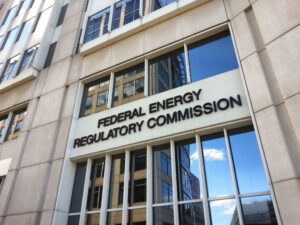By Chuck Sensiba and Elizabeth McCormick
It is well known that hydropower is one of the oldest forms of electricity generation in the United States, with hydropower plants accounting for 99 percent of all currently operating capacity built before 1930. Incredibly, the average hydroelectric facility has been operating for over 60 years, and the 50 oldest electricity-generating plants in the United States are all hydroelectric generators that have been in service since 1908. For projects under the jurisdiction of the Federal Energy Regulatory Commission (FERC), licenses are issued for terms of at least 30 and up to 50 years. It is unsurprising, then, that these facilities are frequently in need of repairs to maintain or improve their safety and stability or to bring them into compliance with ever-changing environmental requirements. As technology advances, many of the owners and operators of these FERC-licensed facilities are also looking to improve their efficiency, reliability, and modernization. Given the near-limitless variety of improvements and repairs that can be implemented over a hydroelectric facility’s long lifetime, it is critical for the owners and operators of hydropower facilities to understand the most efficient and cost-effective ways to achieve these repairs and improvements, which for FERC-licensed facilities are primarily achieved through a license-amendment proceeding. As discussed more fully below, we suggest that licensees consult with FERC regulatory counsel when determining whether a license amendment application may be required; what type of amendment is appropriate; and what other processes, such as consultation with resource agencies or an environmental review process, may be required. Additionally, recent amendments to the Federal Power Act (FPA) provide a significant opportunity for FERC licensees to leverage certain amendments or other improvements to their facilities toward receiving a longer license term upon relicensing.
Licensing Amendments
When considering repairs or upgrades to a FERC-licensed hydroelectric facility, the first consideration for licensees is whether an application for a license amendment is necessary at all. Engaging outside counsel on this question is often helpful in making this determination because, as FERC has stated, “Every change to a license is an amendment,” but importantly, “not all amendments trigger the full panoply of rights and procedures applicable to a license application proceeding.” Articles 2 and 3 of FERC’s standard license require prior FERC approval for substantial changes to the project specifications approved in the license. Insubstantial changes, however, require only that the licensee file as-built exhibits so that FERC can amend the license to reflect the actual specifications. Generally speaking, FERC has found that changes that involve “no substantial modification of the authorized scheme of development” generally do not require an amendment application. For example, FERC has found that a change in the method of estimating project inflows was not a material change in the scheme of development and did not require an amendment application. In these instances, a license amendment application is unnecessary, and a simplified approach—such as a notification letter to FERC staff—would be appropriate.
However, if a licensee determines that a repair or upgrade would involve a “substantial modification of the authorized scheme of development,” then an amendment application is required and the next consideration is whether the proposed change constitutes a capacity or noncapacity amendment. A capacity-related amendment is one that increases the project’s authorized installed capacity by 2 megawatts (MW) or more and increases the hydraulic capacity by 15 percent or more. FERC’s regulations require that applications for capacity-related amendments also include additional information, including an environmental report known as Exhibit E. Applications for noncapacity amendments, on the other hand, must include “only those exhibits that require revision in light of the nature of the proposed amendments.” The exhibits that are required to be filed as part of a noncapacity amendment application can vary considerably depending on the nature of the proposed amendment.
Consultation and Environmental Review
Another major difference between capacity and noncapacity-related license amendments is the amount of prefiling consultation required for each. FERC’s regulations require that applicants for capacity-related amendments undertake a three-stage prefiling consultation process with the appropriate federal and state resource agencies, affected Indian tribes, and members of the public likely to be interested in the proceeding. In the case of a license amendment application, this frequently involves providing these stakeholders with a description or draft of the proposed amendment and soliciting their feedback on the proposal prior to filing the amendment application with FERC for its approval. An applicant for a noncapacity license amendment is only required to consult with resource agencies, tribes, and other stakeholders to the extent that the proposed amendment would affect their interests. In addition to engaging outside counsel to determine what type of amendment and prefiling consultation may be required for a proposed project, it is also helpful to discuss the proposal with FERC staff who can provide additional guidance on what type of amendment application is needed.
Once the necessary prefiling consultation has been completed and an amendment application has been filed with FERC, FERC will issue a notice soliciting interventions and comments from interested parties and will determine whether an environmental assessment or environmental impact statement is required under the National Environmental Policy Act (NEPA). FERC’s regulations also include several categories of actions that are “categorically excluded” under NEPA, such as license amendments that do not require ground-disturbing activity or changes to project works or operation. Following the completion of the environmental review process, FERC or its staff will issue an order regarding its determination on the pending amendment application and providing aggrieved parties the opportunity to seek rehearing and appeal.

Opportunity to Leverage Amendments
While the procedures required to file a license amendment application with FERC are often time and resource intensive, a recent amendment to the FPA provides an opportunity for licensees to leverage the amendment process—along with other types of investments—to obtain a longer license term. In late 2018, Congress passed the America’s Water Infrastructure Act, which, among other things, adds a new section, section 36, to the FPA. Section 36(b) provides that FERC, when establishing the term of a new license,
“shall give equal weight to:
(1) investments by the licensee to implement the new license… including investments relating to redevelopment, new construction, new capacity, efficiency, modernization, rehabilitation or replacement of major equipment, safety improvements, or environmental, recreation, or other protection, mitigation, or enhancement measures required or authorized by the new license; and
(2) investments by the licensee over the term of the existing license (including any terms under annual licenses) that—
(A) resulted in redevelopment, new construction, new capacity, efficiency, modernization, rehabilitation, or replacement of major equipment, safety improvements, or environmental, recreation, or other protection, mitigation, or enhancement measures conducted over the term of the existing license; and
(B) were not expressly considered by the Commission as contributing to the length of the existing license term in any order establishing or extending the existing license term.”
In addition to requiring FERC to consider these investments, made over the course of the existing license term, FPA section 36(c) provides an opportunity for hydropower licensees to obtain a FERC determination at any time as to whether any planned, ongoing, or completed investment meets the criteria of subsection (b)(2) above. Section 36(c) provides that a determination under this subsection shall be issued within 60 days following receipt of the licensee’s request.
Since section 36 of the FPA was enacted just over 2 years ago, licensees have taken advantage of this new statutory program to identify major investments made during the projects’ license terms, in some cases dating back over 30 years. These improvements—all of which FERC found satisfied the section 36(b) criteria—ranged from seismic upgrades and other dam safety improvements to the rehabilitation and replacement of turbine-generator units. Thus, any licensee that has completed or plans to make significant license amendments or other improvements during its current license term should consult with counsel to determine how to most effectively make a request for a determination under section 36(c) to amortize the cost of these measures over a longer license term.
 Chuck Sensiba is a partner in Troutman Pepper’s Washington, DC, office. He can be reached at charles.sensiba@troutman.com.
Chuck Sensiba is a partner in Troutman Pepper’s Washington, DC, office. He can be reached at charles.sensiba@troutman.com.
 Elizabeth McCormick is an associate in Troutman Pepper’s Washington, DC, office. She can be reached at elizabeth.mccormick@troutman.com.
Elizabeth McCormick is an associate in Troutman Pepper’s Washington, DC, office. She can be reached at elizabeth.mccormick@troutman.com.

